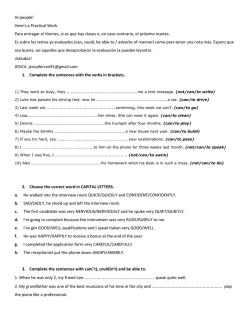
WWDR January 2015 - WorldWide Drilling Resource
Pickle Jars as a Solution to Seeing in Dirty Water ~ Really? by Ray Roerick Sales Manager, Well-Vu, Inc. Everyone who owns a down hole camera, and used it on a few wells, has encountered the “I can’t see anything once the camera goes into the water” scenario. Well, you might just have a simple solution in the fridge or kitchen cupboard. Obtain a clear plastic or glass container, such as a pickle jar. Glass seems to work best and does not scratch as easily as plastic. Either way, you want a jar that is smooth, with rounded shoulders on the bottom. If the glass is dis- torted or has “ripples” in it, the picture you get from your camera will also be distorted. What you want to look for is a jar that is 1/4 to 3/4-inches smaller than the inside diameter of the casing you want to video (i.e. a 5-1/2-inch OD [outside diameter] jar for a 6-inch well or a 7-1/2-inch OD jar for an 8-inch ID [inside diameter] well). Drill a hole in the center of the lid slightly larger than your cable diameter, and cut a slot from the edge of the lid to the hole for the cable to slide in. Next, slide the cable through the cut slot to the center hole and fill the bottle with fresh, clean, bottled or tap water. Insert the camera into the bottle, screw on the lid, then tape the slot in the lid. As a precaution, tape the lid to the jar. The tensile strength of the camera cable will very easily support the weight of jar and water. If you chose to use a clear plastic bottle with a small top, simply cut a slot in the top of the bottle to insert the camera and cable through, fill with clean water, and tape the neck shut. The only problem I have found with the plastic containers is they scratch quite easily on steel-cased wells, and you only get one or two uses out of them. In either case, when lowering this into the water, the jar will displace the dirty well water except for 1/8 to 1/2 inch or so on the side of your bottle, allowing the camera to see through the clean water in the jar. It will only need to look through a very thin portion of dirty well water. The only downside I found is I was eating a lot of pickles for awhile to empty the jars! Ray michele@ worldwidedrillingresource.com Frascos de Pepinillos como la Solución para ver en el Agua Sucia ~ ¿En serio? por Ray Roerick Gerente de Ventas, Well-Vu, Inc. Hector Leos Translator Todo aquel que es dueño de una cámara para posos, y la ha utilizado, se ha encontrado con esto “No puedo ver nada una vez que la cámara entra en el agua”. Bueno, puede que tenga 42 JANUARY 2015 una solución simple en el refrigerador o el armario de la cocina. Obtenga un recipiente de plástico o vidrio claro, tal como un frasco de pepinillos. El vidrio parece funcionar mejor y no se raspa tan fácilmente como el plástico. De cualquier manera, usted necesita un frasco que sea liso, con orillas redondeadas en la parte inferior. Si el cristal está distorsionado o tiene “ondas”, la imagen que se obtiene de la cámara también se distorsionará. Lo que se bebe buscar es un frasco que sea de 1/4 a 3/4 pulgadas más pequeño que el diámetro interior del revestimiento que desea video grabar (es decir, un frasco de 5-1/2 pulgadas [diámetro exterior] para un poso de 6 pulgadas o un frasco de 7-1/2 pulgadas para un poso de 8 pulgadas [diámetro interior]). Perfore un agujero en el centro de la tapa ligeramente más grande que el diámetro del cable, corte una ranura desde el borde de la tapa hacia el orificio para que el cable se deslice. A continuación, deslice el cable a través de la ranura hacia el agujero central y llene el frasco con agua fresca, limpia, embotellada o del grifo. Coloque la cámara en el frasco, apriete bien la tapa, y luego cubra con cinta adhesiva la ranura en la tapa. Como precaución, pegue la tapa al frasco. La resistencia a la tracción del cable de la cámara soportara muy fácilmente el peso del frasco y el agua. Si decide utilizar una botella de plástico transparente con tapa pequeña, simplemente corte una ranura en la parte superior de la botella para insertar la cámara y atravesar el cable, llénelo con agua limpia, y selle el cuello de la botella con cinta adhesiva. El único problema que he encontrado con los envases de plástico es que se raspan con facilidad en pozos revestidos de acero, y sólo pueden ser utilizados un par de veces. En cualquier caso, al bajar en el agua, el frasco desplazará el agua sucia del pozo con excepción de 1/8 a 1/2 pulgada más o menos por el lado de la botella, lo que permite que la cámara pueda ver a través del agua limpia en el frasco. Sólo tendrá que mirar a través de una porción muy fina de agua sucia del pozo. ¡El único inconveniente que he encontré es que termine comiendo muchos pepinillos por un tiempo para vaciar los frascos! Ray michele@ worldwidedrillingresource.com WorldWide Drilling Resource ®
© Copyright 2025



